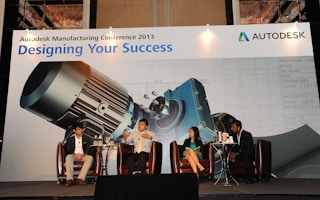What is sustainable manufacturing?
To continue reading, subscribe to Eco‑Business.
There's something for everyone. We offer a range of subscription plans.
- Access our stories and receive our Insights Weekly newsletter with the free EB Member plan.
- Unlock unlimited access to our content and archive with EB Circle.
- Publish your content with EB Premium.
This was a question posed to a panel discussion I spoke at last week at the Autodesk Manufacturing Conference held at Singapore’s St Regis hotel.
My fellow panellist Dr Tan Boon Kiat, senior industry development manager at the Singapore Institute of Manufacturing Technology (SIMTech), and I were surprised by the question initially. After all, participants at the event had been discussing sustainable manufacturing through the day.
But the question threw into sharp focus that sustainable manufacturing is a concept not easily grasped by many in the industry.
Firstly, what does it mean to be sustainable? Participants I spoke to argue that manufacturing companies, by virtue of their existence, are sustainable. If they were not, they’d be out of business.
But sustainable manufacturing – or green manufacturing, as it is also known – goes beyond being sustainable in dollars and cents.
Green manufacturing, going by a UNEP (United Nations Environment Programme) definition, differs from conventional manufacturing in that it aims to reduce the amount of natural resources needed to produce finished goods through more energy- and materials-efficient manufacturing processes that also reduce the negative externalities associated with waste and pollution.
Put simply, it means making goods with as little resources as possible, and best of all, without any waste.
One example I cited at the panel discussion was a project involving H.P. Bulmer, the world’s leading hard-cider maker and apple grower and user. You can read more about it here from the Rocky Mountain Institute. Essentially, Bulmer decided to re-think its entire manufacturing process with sustainability as the main driver.
The Institute organized a four-day intensive design workshop, also known as a ‘charrette’, which scrutinised Bulmer’s operations. Besides making recommendations for new products or equipment, new processes, reducing resource use, and promoting efficiency, it also looked Bulmer’s business and included agriculture specialists as well as biologists.
“
Rising business costs will force companies to embrace green or sustainable manufacturing, whether they like it or not. Increasingly educated consumers are also demanding goods and services that are responsible and are sustainable. Those who stubbornly cling on to business-as-usual will find themselves out of business in the near future.
One radical idea to emerge was that instead of burning some 10,000 tonnes of apple wood chip waste as energy, the company realised this waste stream could work even harder as an excellent feedstock for growing shiitake mushrooms, producing additional revenue that could have exceeded that from cider sales.The agricultural waste from growing this additional crop was turned into fertiliser, which then nourished the grounds on which the apple trees grew on.
It was a process that mimicked nature – where every waste stream is converted into something useful.
There are many other solid business stories of how one man’s trash is another man’s treasure.
In the palm oil industry, for example, businesses are turning the agricultural waste from the manufacturing process into compost or fertiliser, or using it the waste as feedstock to make biodegradable disposable cutlery.
In some other circles, this approach is also referred to as ‘cradle to cradle’. This refers to systems that are not only efficient but also essentially waste free.
Some other sustainable manufacturing practices include remanufacturing, Dr Tan’s area of expertise. He explained that remanufacturing converts used products and components into new ones with like-new quality.
SIMTech has research labs that develop remanufacturing-related technologies such as refurbishing and reliability assessment. Refurbishing technologies include cleaning, cladding, welding, and surface treatment to recover the functionality of the parts to be remanufactured. Reliability assessment technologies evaluate the remanufacturability of the remanufactured parts and to assure their warranty.
He added that engineers today have an array of software tools which can simulate the interactions of the material, energy and waste flows within a process. The tools, such as Autodesk’s Eco Materials Adviser, provide engineers and designers with the options available to reduce carbon footprint, material and energy consumptions, and waste.
This helps them save time and resources, and identifies potential design flaws and pitfalls earlier, as compared to the older ways of physical proto-typing.
This is the sort of thinking that every manufacturer today needs to embrace, in order to survive tomorrow.
According to UNEP reports, manufacturing is responsible for about 35 per cent of the global electricity use, over 20 per cent of carbon emissions and over a quarter of primary resource extraction.
It also accounts for up to 17 per cent of air pollution-related health damages. Gross air pollution damages are equivalent to between 1 and 5 per cent of global GDP.
As the world population reaches 9 billion by 2050, the demand for goods and services is set to increase exponentially at a time where resources are dwindling. Rising business costs will force companies to embrace green or sustainable manufacturing, whether they like it or not. Increasingly educated consumers are also demanding goods and services that are responsible and are sustainable.
Those who stubbornly cling on to business-as-usual will find themselves out of business in the near future. (The OECD has a useful sustainable manufacturing toolkit here to help companies take that first step in the journey.)
As the discussion concluded, panellists agreed on one thing – sustainable manufacturing is a misnomer, because it is a matter of time before all manufacturing has to be sustainable.









